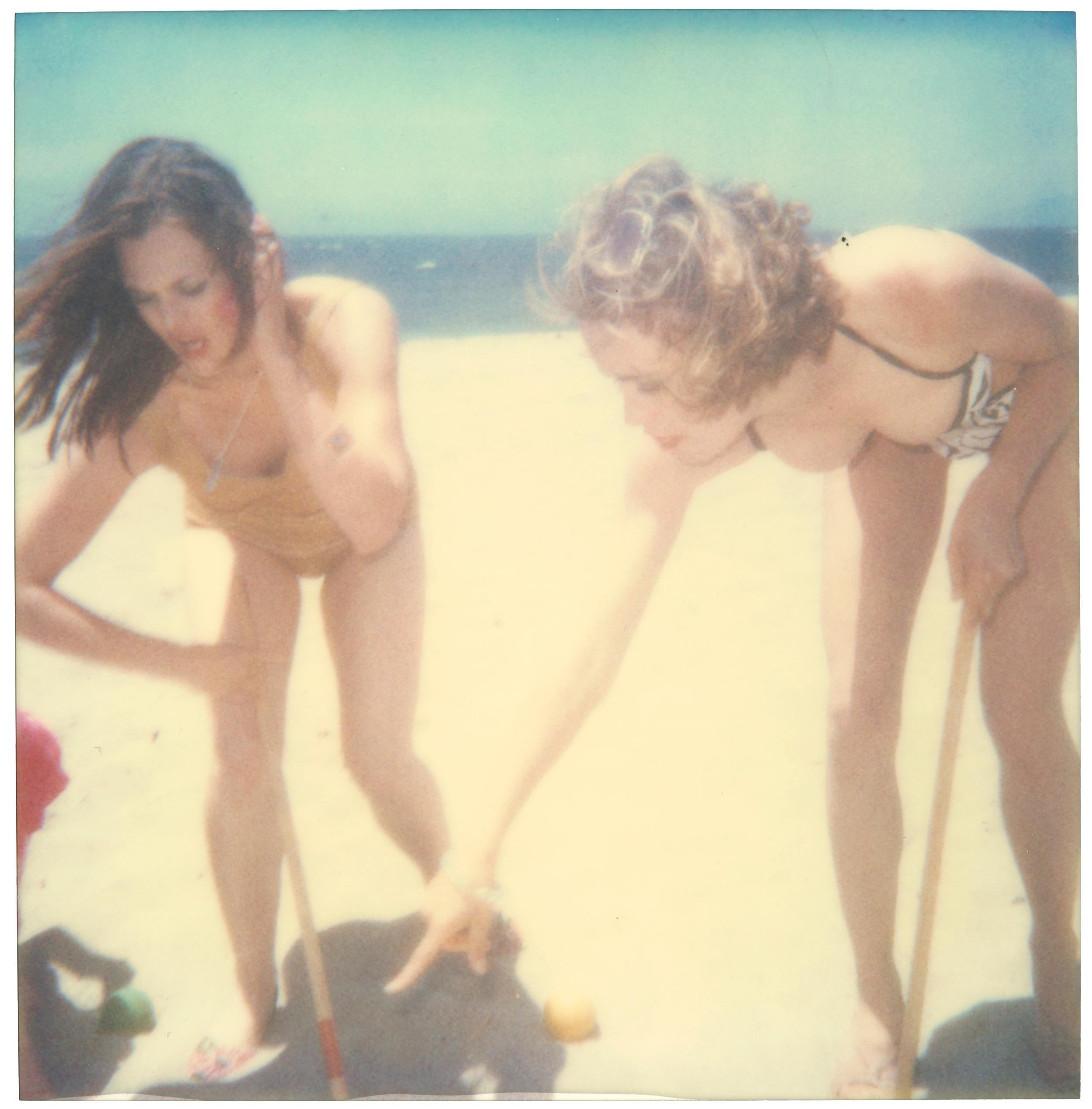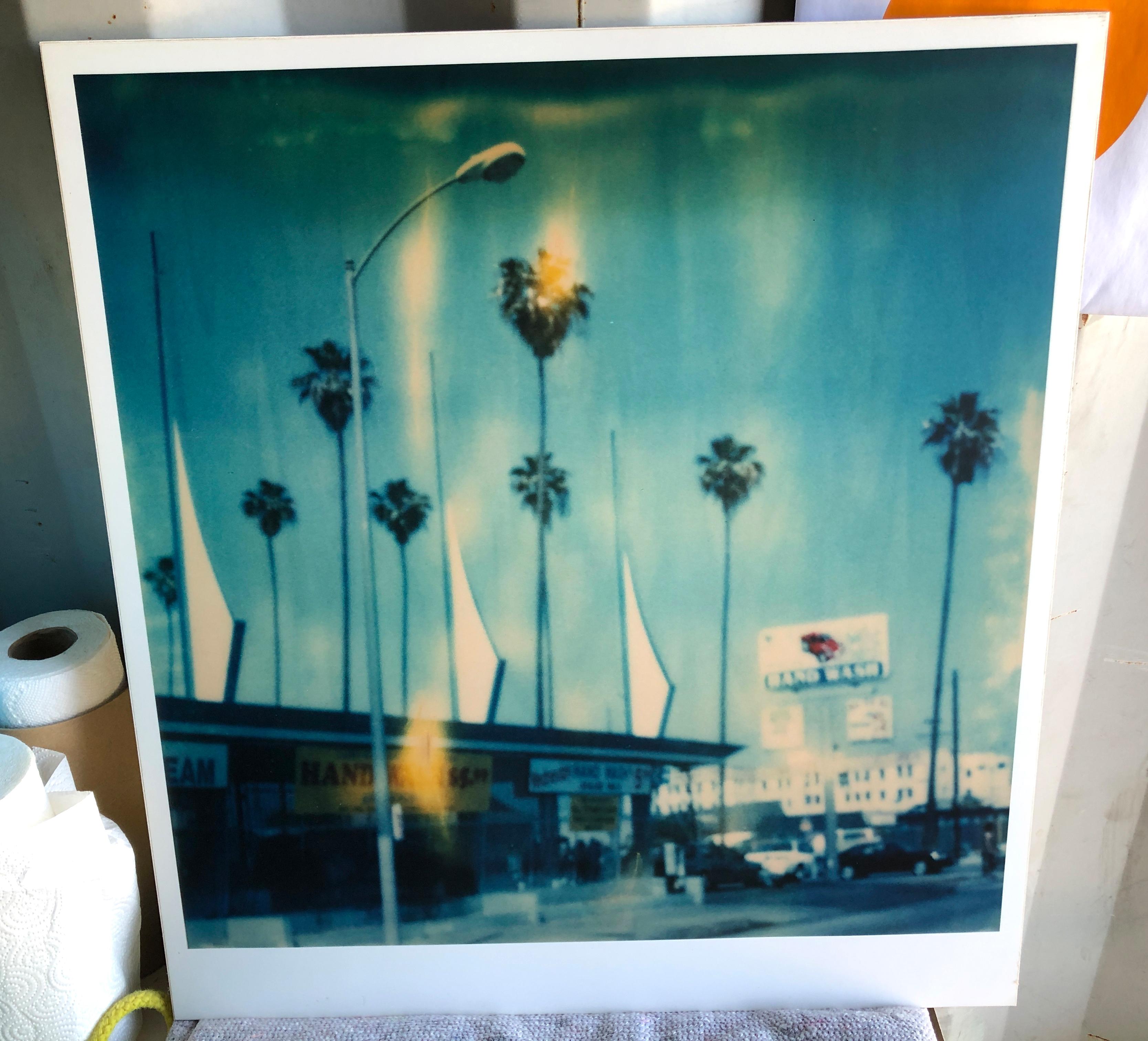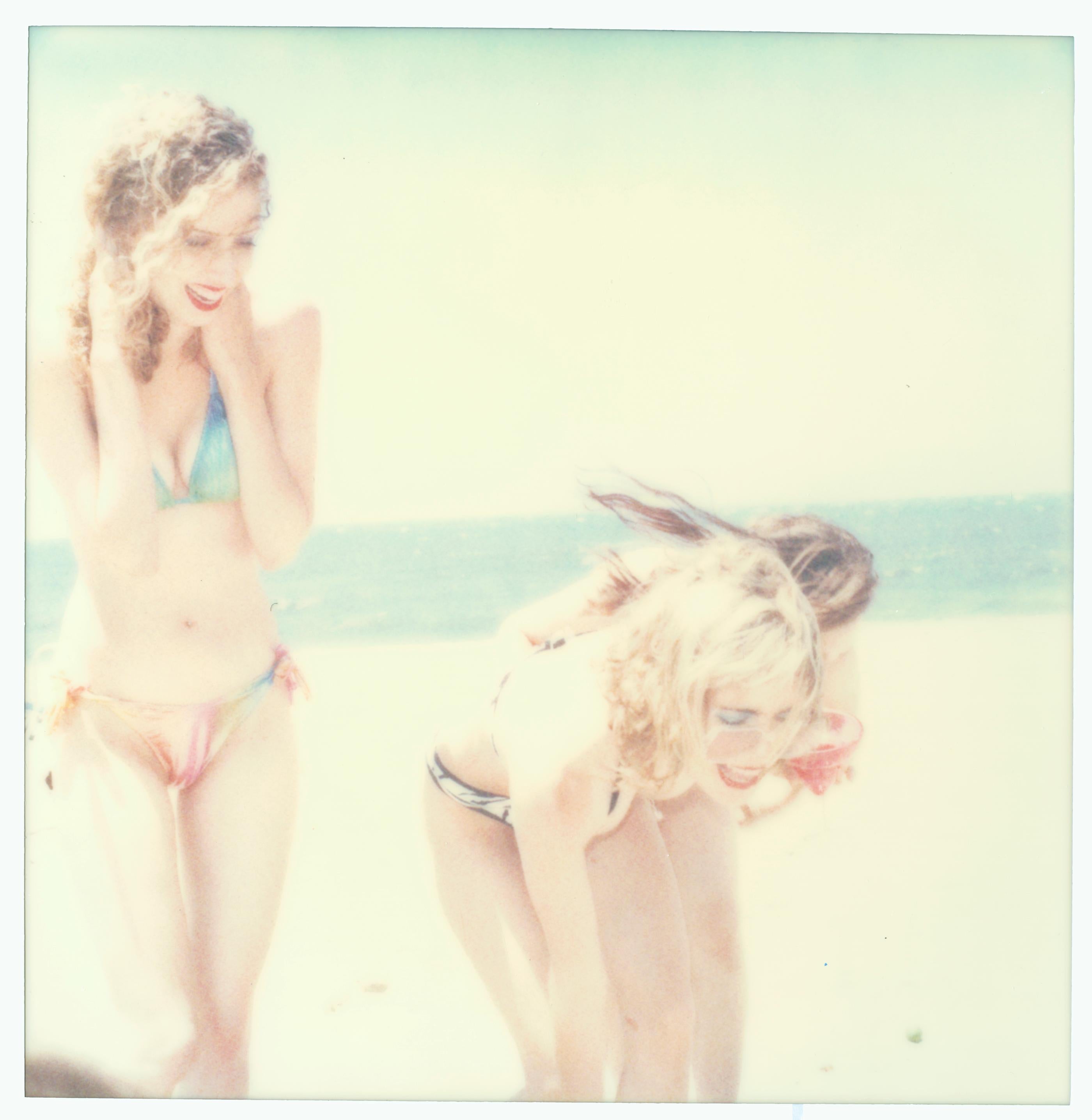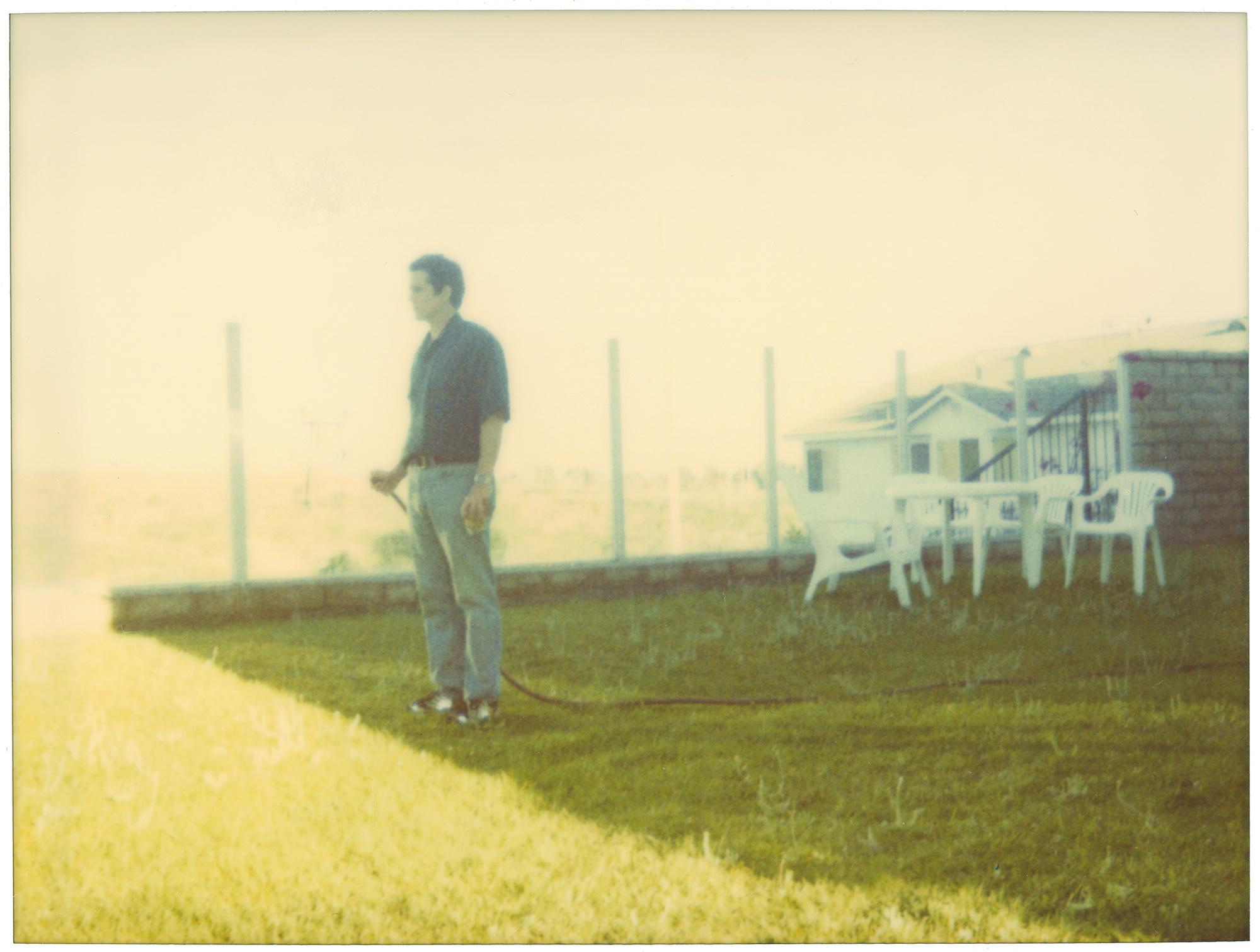Items Similar to Dust Bowl Blues (Heavenly Falls)
Want more images or videos?
Request additional images or videos from the seller
1 of 5
Stefanie SchneiderDust Bowl Blues (Heavenly Falls)2016
2016
About the Item
Dust Bowl Blues (Heavenly Falls)
2016, 20x24cm, Edition 2/10,
digital C-Print based on a Polaroid.
Certificate and signature label.
Artist inventory number: 19651.02
Not mounted
Stefanie Schneider interviewed by Dutch Filmmaker Willem Baptist
When did you first decide to work with Polaroids? Why do Polaroids seem to be so well tuned to our (artistic) senses, perception and minds?
I started using expired Polaroid film in 1996. It has the most beautiful quality and perfectly encapsulates my vision. The colors on one hand, but then the magic moment of witnessing the image appear. Time seems to stand still, and the act of watching the image develop can be shared with the people around you. It captures a moment, which becomes the past so instantly that the decay of time is even more apparent; – it gives the image a certain sentimentality. The Polaroid moment is an original every time. An artifact.
Why use a medium from the past?
For me, analog has always been there in the present. For the new generation, analog is interesting because it's new to them. I understand that people growing up in a digital age will wonder about its usefulness, but it's theirs to recover if they want to. When I first started working with Polaroid, it wasn't the past. It was a partially forgotten medium, but it existed nonetheless. It is mine by choice as there is no substitute for tangible beauty.
Is it imperfect?
The imperfect perfection in a “wabi-sabi” kind of way.
Wabi-sabi (侘寂) represents a comprehensive Japanese world view or aesthetic centered on the acceptance of transience and imperfection. The aesthetic is sometimes described as one of beauty that is imperfect, impermanent, and incomplete.
'If an object or expression can bring about, within us, a sense of serene melancholy and a spiritual longing, then that object could be said to be wabi-sabi'. 'Wabi-sabi nurtures all that is authentic by acknowledging three simple realities: nothing lasts, nothing is finished, and nothing is perfect.'
Is the Polaroid photograph recognizable or even sometimes cliché?
Absolutely! There's something cliché about the way I'm showing the American Dream. I live it myself, trying to find perfection in an imperfect world. Reaching for the horizon. The dream is broken; the cliché tumbles. There are different ways to involve an audience. You could make movies like Harmony Korine's 'Gummo' a masterpiece in my view but which would probably estrange a large part of an audience. A certain film education is a prerequisite. Or you can start with clichés, the audience then feels safe, which lures them into the depth of your world without them even knowing it or understanding where exactly they are being led to. Appealing to emotions and the sub-conscious. Normal, Change, New Normal.
You continually revisit the landscape of the American West in your work. What draws you back to this scene?
Southern California represents a dream to me. The contrast of Northern Germany, where I grew up, to the endless sunshine of Los Angeles was what first attracted me. The American West is my dream of choice. Wide, open spaces give perspectives that articulate emotions and desires. Isolation feeds feelings of freedom or sometimes the pondering of your past. The High Desert of 29 Palms has very clear and vivid light, which is vital. Expired Polaroid film produces 'imperfections' that I would argue mirrors the decline of the American dream. These so called 'imperfections' illustrate the reality of that dream turning into a nightmare. The disintegration of Western society.
Are you playing with the temporality of the material and the value of the moment itself?
The value of the moment is paramount, for it is that moment that you're trying to transform. All material is temporary, it's relative, and time is forever.
Why does analog film feel more pure and intuitive?
It's tangible and bright and represents a single moment.
The digital moment may stay in the box (the hard drive / camera / computer etc.)
forever, never to be touched, or put into a photo album, sent in a letter, or hung on a wall.
Printing makes it an accomplishment.
The analog world is more selective because it's real. Film is a choice.
The digital worldwide clicking destroys this moment. The generation without memories due to information overload and hard drive failures. Photo albums are a thing of the past.
Why does it feel this way?
That's how the human instinct works.
When I was a child, every picture been taken was a special moment. Analog photographic film as well as Super-8 material were expensive treasures. My family's memories were created by choosing certain moments in time. There was an effort behind the picture. The roll of film might wait months inside the camera before it was all used. From there, the film required developing, which took more time, and finally, when the photos were picked up from the shop, the memories were visited again together as a family. Who knew then, how fleeting these times were. Shared memories was a ritual.
What's your philosophy behind the art of Polaroid pictures?
The 'obsolete' is anything but obsolete. Things are not always as they appear, and there are hidden messages. Our memories and our dreams are under-valued. It is there that real learning and understanding begins by opening yourself to different perspectives. Who we are and where we come from is important. A Polaroid is a testimony to our existence. But our time is fading fast.
What inspired you to use stop motion cinematography?
My work has always resembled movie stills. I remember the first time I brought a box of Polaroids and slid them onto Susanne Vielmetter's desk (my first gallery). Instantly, it became apparent that there was a story to tell. The stories grew. It was undeniable to me, that the emerging story was where I was destined to go. I've made four short films before my latest feature film, The Girl behind the White Picket Fence. This film is 60 minutes long with over 4000 edited Polaroids. Remember that our sub-conscious fills in blanks, the parts missing from the story between photograph stills allow a deeper and more personal experience for the viewer. That is, if you surrender yourself and trust me as the director to lead you somewhere you might not have ever been before.
Why do you think it is important to own art?
'We have art in order not to die of the truth'
Nietzsche
Stefanie Schneider was born and raised in Cuxhaven, Germany but lives and works in Southern California. Exploring the American dream and capturing it with Polaroid instant film. Situated on the verge of an elusive super-reality, her photographic sequences provide the ambience for loosely woven story lines and a cast of phantasmic characters that reflect a part of the narrators life told from her perspective. Often about love, communication. sexuality and relationships. Schneider works with the chemical mutations of expired polaroid film stock. Chemical explosions of color spreading across the surfaces undermine the photograph's commitment to reality and induce her characters into trance-like dreamscapes. Like flickering sequences of old road movies Schneider's images seem to evaporate before conclusions can be made - their ephemeral reality manifesting in subtle gestures and mysterious motives. Schneider's images refuse to succumb to reality, they keep alive the confusions of dream, desire, fact, and fiction yet they also explore the relationship with the medium and the viewer. The wabi sabi 'ness' of Schneider's work can not be denied or ignored. It's a step of acceptance of 'flaws', gaps and distortions. Missing pieces of the puzzle. The artist flaunts, uses and exposes the unknown using expired Polaroid instant film intentionally. Presents it. What you do with that is up to you. That missing part of the picture is for you to include yourself, you fill it in with yourself. That might be critical that it's there at all, missing and missing the entire point all together or by filling in the unknown with their own imagination. Even their own memories which then integrats the viewer and artist as one with limitless potential.
- Creator:Stefanie Schneider (1968, German)
- Creation Year:2016
- Dimensions:Height: 19.69 in (50 cm)Width: 19.69 in (50 cm)Depth: 0.04 in (1 mm)
- More Editions & Sizes:20x20cm, Edition of 10Price: $327
- Medium:
- Movement & Style:
- Period:
- Condition:
- Gallery Location:Morongo Valley, CA
- Reference Number:
About the Seller
4.9
Platinum Seller
These expertly vetted sellers are 1stDibs' most experienced sellers and are rated highest by our customers.
Established in 1996
1stDibs seller since 2017
953 sales on 1stDibs
Typical response time: 2 hours
- ShippingRetrieving quote...Ships From: Morongo Valley, CA
- Return PolicyA return for this item may be initiated within 7 days of delivery.
More From This SellerView All
- Happiness (Suburbia) - with Radha Mitchell - Contemporary, PolaroidBy Stefanie SchneiderLocated in Morongo Valley, CAHappiness (Suburbia) - 2004 28x37cm, Edition of 10, Archival C-Print based on the Polaroid. Signature label with Certificate, Not mounted. Artist Inventory # 408. Stefanie Schn...Category
Early 2000s Contemporary Figurative Photography
MaterialsArchival Paper, Photographic Paper, C Print, Color, Polaroid
- Boccia I (Beachshoot ) with Radha Mitchell -Polaroid, Contemporary, Women, ColorBy Stefanie SchneiderLocated in Morongo Valley, CABoccia I (Beachshoot) - 2005 38x36cm, Edition of 10. Archival C-Print, based on the Polaroid. Certificate and Signature label. Artist Inventory # 1467. Not mounted. featuring Cam...Category
Early 2000s Contemporary Color Photography
MaterialsArchival Paper, Photographic Paper, C Print, Color, Polaroid
- Car Wash - Contemporary, Landscape, Cityscape, expired, Polaroid, analog, BlueBy Stefanie SchneiderLocated in Morongo Valley, CACar Wash (Stranger than Paradise) - 1999 64.6x59.5cm including the white 'Polaroid' frame. Edition 2/10. Analog C-Print, hand-printed by the artist, mounted on Aluminum with mat...Category
Early 2000s Contemporary Color Photography
MaterialsMetal
- Boccia V (Beachshoot ) with Radha Mitchell - Polaroid, Contemporary, WomenBy Stefanie SchneiderLocated in Morongo Valley, CABoccia V (Beachshoot) - 2005 38x37cm, Edition of 10 Archival C-Print, based on the Polaroid. Certificate and Signature label. Artist Inventory # 1467_5. Not mounted. featuring Ca...Category
Early 2000s Contemporary Color Photography
MaterialsArchival Paper, Photographic Paper, C Print, Color, Polaroid
- Bourbon (Suburbia) featuring Louis Ferreira, analog, mountedBy Stefanie SchneiderLocated in Morongo Valley, CABourbon (Suburbia) - 2004 Edition of 2/5, 60x80cm. Analog C-Print, hand-printed by the artist based on the Polaroid, mounted on Aluminum with matte UV-Protection. Artist Inventor...Category
Early 2000s Contemporary Color Photography
MaterialsMetal
- Boccia IV (Beachshoot ) with Radha Mitchell -Polaroid, Contemporary, WomenBy Stefanie SchneiderLocated in Morongo Valley, CABoccia IV (Beachshoot) - 2005 38x36cm, Edition of 10. Archival C-Print, based on the Polaroid. Certificate and Signature label. Artist Inventory # 1467. Not mounted. Beachshoot ...Category
Early 2000s Contemporary Color Photography
MaterialsArchival Paper, Photographic Paper, C Print, Color, Polaroid
You May Also Like
- Tyler Shields - Strawberry, Photography 2024, Printed AfterBy Tyler ShieldsLocated in Greenwich, CTSeries: Indulgence Chromogenic Print on Kodak Endura Luster Paper All available sizes and editions: 18" x 18" 30" x 30" 45" x 45" 60" x 60" Editions of 3 + 2 Artist Proofs Tyler Shi...Category
2010s Contemporary Figurative Photography
MaterialsLuster, Paper, Archival Paper, Photographic Paper, C Print, Digital, Arc...
- Tyler Shields - The Mouth, Photography 2017, Printed AfterBy Tyler ShieldsLocated in Greenwich, CTSeries: Mouths Chromogenic Print on Kodak Endura Luster Paper All available sizes and editions: 18" x 18" 30" x 30" 45" x 45" 60" x 60" 70" x 70" Editions of 3 + 2 Artist Proofs Tyl...Category
2010s Contemporary Color Photography
MaterialsLuster, Archival Paper, C Print, Paper
- Peter Andrew Lusztyk - Lego "Cowboy", Photography 2021, Printed AfterBy Peter Andrew LusztykLocated in Greenwich, CTLego "Cowboy" Digital C-Print / Archival Pigment Print Edition of 5 per size Available sizes: 36 x 24 48 x 36 60 x 48 “Collectible” series is a macro level exploration of coins, bil...Category
2010s Contemporary Color Photography
MaterialsArchival Paper, Photographic Paper, C Print, Digital, Pigment, Digital P...
- Peter Andrew Lusztyk - Lego "Garçon / Waiter", Photography 2021, Printed AfterBy Peter Andrew LusztykLocated in Greenwich, CTLego "Garçon / Waiter" Digital C-Print / Archival Pigment Print Edition of 5 per size Available sizes: 36 x 24 48 x 36 60 x 48 “Collectible” series is a macro level exploration of c...Category
2010s Contemporary Color Photography
MaterialsArchival Paper, Photographic Paper, C Print, Digital, Pigment, Digital P...
- Peter Andrew Lusztyk - Montreal, Photography 2021, Printed AfterBy Peter Andrew LusztykLocated in Greenwich, CTMontreal I Digital C-Print / Archival Pigment Print Edition of 10 per size Available sizes: 40 x 60 in 60 x 90 in Since its inception, Lusztyk’s Interchanges project has taken the a...Category
2010s Contemporary Color Photography
MaterialsArchival Paper, Photographic Paper, C Print, Digital, Pigment, Digital P...
- Peter Andrew Lusztyk - Lego "Astro", Photography 2021, Printed AfterBy Peter Andrew LusztykLocated in Greenwich, CTLego "Astro" Digital C-Print / Archival Pigment Print Edition of 5 per size Available sizes: 36 x 24 48 x 36 60 x 48 “Collectible” series is a macro level exploration of coins, bill...Category
2010s Contemporary Color Photography
MaterialsArchival Paper, Photographic Paper, C Print, Digital, Pigment, Digital P...





